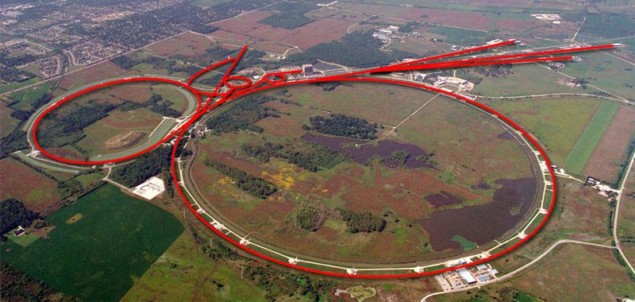
Fermilab’s Tevatron collider looks set for a new lease on life following a campaign to keep the facility running beyond the end of 2011. A report by Fermilab’s Physics Advisory Committee (PAC) due to be released later today is expected to recommend that collisions at the Tevatron continue until 2014 – long enough, say advocates, to search the entire range of likely masses for the Higgs boson, and perhaps even find the first evidence of its existence.
Pressure to keep the Tevatron running has been building for months thanks to a combination of factors, including the 15 month shutdown of the rival Large Hadron Collider (LHC) at CERN for repairs as well as a continued stream of results from the Tevatron’s two main detector experiments, CDF and D0. In late July, a group of 38 US physicists unaffiliated with Fermilab sent a letter to Energy Secretary Steve Chu, asking the Department of Energy (DOE) to support an extension. “We feel there’s a lot to be gained from running the Tevatron for a few more years,” says Harvard University theorist Lisa Randall, one of the letter’s signatories. “It is running incredibly well, and from a pure physics standpoint, it would be such a loss to stop now”.
Independent teams working at CDF and D0 have already collected enough data to be 95% confident that the Higgs mass does not lie between 158–175 GeV – a range near what CDF co-spokesperson Rob Roser termed the collider’s “energy sweet spot”. A three-year extension would produce enough data to broaden this search to the rest of the 114–185 GeV mass range that theorists deem most likely to contain the Higgs, and provide at least a 3-sigma level of confidence in any signal observed. Although not enough to qualify as a “discovery”, a 3-sigma signal would still constitute important “evidence” for the elusive Higgs, Roser says.
Keeping the Tevatron going would not be without costs, however. In addition to the estimated $60m per-year price of running the collider, an extension would also delay other Fermilab projects. One of the hardest hit would be the NOvA neutrino experiment, which is due to start in 2013. NOvA is designed to study neutrinos produced when protons from Fermilab’s main injector ring slam into a graphite target, but continuing operations at the Tevatron would leave fewer protons available for the NOvA beam. According to NOvA co-spokesperson Gary Feldman, the combined effects of reduced beam power and inconvenient shutdown periods associated with a three-year Tevatron extension would halve the amount of data NOvA could collect in its first three years of operation.
The recommendations of the PAC, which is composed of 14 external scientists and one Fermilab employee, are not binding and it will be up to the lab’s director, Pier Oddone, to determine an official lab response. One possible compromise would be to extend Tevatron operations for just one year. This would only delay NOvA by six months, thanks to overlapping upgrade and shutdown schedules, Fermilab deputy director Young-Kee Kim told physicsworld.com ahead of the PAC meeting on 27 August. A yearlong extension could also meet with DOE approval relatively quickly, she added, noting that the Tevatron received a similar one-year reprieve less than a year ago. “The whole community would like to see this extension happen, but we have to consider the impact on other projects,” Kim told physicsworld.com. “We will make somebody unhappy whatever we decide.”



